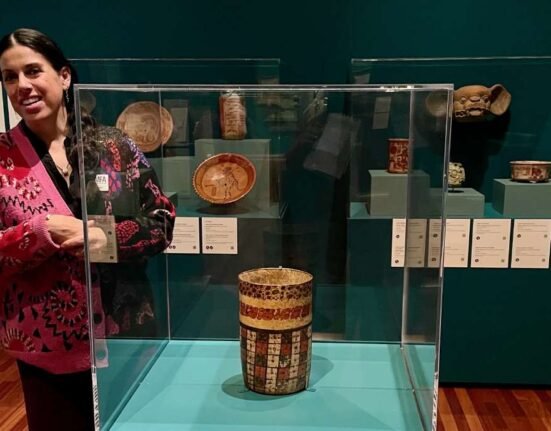“The values that I bring to the work are the values that will serve this institution,” Terjanian said in an interview while overlooking the museum’s Calderwood courtyard. “I’m interested in how we’re going to present art and interpretation in a way that creates a more emotional connection — not just an intellectual one — learning something new, but also something that leaves you speechless.”
Perhaps surprisingly, Terjanian, 56, did not initially apply for the museum’s top job. He’d been at the MFA less than a year when Teitelbaum announced he was stepping down. Terjanian was still “in a growth mode,” he said, learning the ins and outs of the cavernous institution. But then the search committee invited Terjanian to apply after distributing some 1,800 surveys to museum staff, trustees, advisers, and other stakeholders in Greater Boston.
“Pierre’s name came up again and again from nearly every corner of the institution and from our community — and it’s no surprise,” MFA Board of Trustees president Emi M. Winterer said in a statement. He “has all the intangibles to lead an institution as storied and significant as the MFA.”
Board chair Marc S. Plonskier said the fact that Terjanian’s colleagues nominated him for consideration signifies two things: “The first is Pierre’s humility; the second is the high regard with which his colleagues think of him.”
“Pierre’s a great communicator, he’s a great listener, and he believes in the MFA — in its greatness and in its mission,” said Plonskier, who added that both the committee and candidate pool were “very diverse.” “That’s the kind of leader that we need.”
Raised in Strasbourg, France, Terjanian began his US career in 1997, working first as an associate curator of arms and armor at the Philadelphia Museum of Art. He moved to the Metropolitan Museum of Art in New York in 2012, where for roughly a decade he oversaw its global collection of arms and armor that spans from the Stone Age to the present.
He arrived at the MFA in January 2024, where he’s led the museum’s varied curatorial teams — everything from the art of Egypt to contemporary art — and quickly became a staff favorite.
“I’m not walking in with the plan, but I have a vision,” said Terjanian, who began the application process in October. “That would include making the permanent collection more relevant, more of a destination, honoring and celebrating the distinctive achievements of particular cultures” while also using the permanent collection to showcase ”something that’s more about the shared humanity that brings people together.”
Even so, Terjanian, who became a US citizen in December, inherits a museum facing several large questions. Though audience numbers are improving, attendance has not fully recovered since the pandemic. The museum is still closed on Tuesdays, and staff morale, which plummeted during the pandemic as the museum shed more than 100 jobs and workers voted to unionize, remains uneasy, with staffing levels below pre-pandemic numbers.
The philanthropic landscape is also shifting, as younger donors seek to support bespoke causes or smaller, culturally specific organizations. Meanwhile, the MFA, like many other cultural organizations, continues to court diverse audiences, an effort that faces backlash from the Trump administration, which has sought to defund projects that champion diversity, equity, and inclusion.
A partial answer to many of these questions, Terjanian said, is to build trusting relationships — with potential donors, staff, and community members across Greater Boston.
“A lot of the work is about building the right partnerships to be closer to the community,” said Terjanian. He pointed to an ongoing exhibition of Boston artist John Wilson, for which curators sought community input, as an example. It’s “so important, because it gives different authority to the message, and it also surfaces nuances we have a responsibility to provide — nuance in a world where a lot of reduction is tempting.”
It’s also a moment of great opportunity. Terjanian said the MFA will continue to create collections of record for specific artists, pointing out that the museum has acquired numerous works by Wilson as well as by leading Boston Expressionist Hyman Bloom.
Meanwhile, Terjanian said, the museum has several capital projects to consider. In addition to an ongoing effort to make the stone-pillared museum more welcoming, Terjanian said a broader “campus planning” is in the works. This would not only include the museum’s projects to reopen and reclaim gallery space that had been put to other uses, but will also consider the adjacent Forsyth Institute building, a roughly 100,000 square foot structure the museum leases to Northeastern University.
“It’s to be determined,” said Terjanian. ”We’re talking about moving forward with the work to see how those buildings serve or complement each other.”
Teitelbaum, who arrived at the MFA 10 years ago, called it an “honor” to pass MFA leadership on to Terjanian, whom he described as “an inspiring colleague.”
He “believes strongly in the role of art and museums, and the importance of culture and community,” Teitelbaum said in a statement. “His dedication to the curatorial field, and across museum functions, is deeply informed by his unwavering commitment to inquiry, strategy, and working with others to address the critical issues facing public institutions today.”
Terjanian, who co-chaired the Met’s reopening task force during the pandemic, also secured some $100 million in gifts, promised gifts, bequests, and pledges of works of art for the museum.
He was awarded the Marica Vilcek Prize in Art History in 2024 for his work with the Met’s arms and armor collection, and the French government named him a Chevalier de l’ordre des Arts et de Lettres over the winter.
Nevertheless, Terjanian, who has two children with his wife, Sonya, has rented an apartment in the South End since arriving in Boston rather than committing to buying a home.
“I’ll be frank,” he said, “I wanted to see if I could pass the test.”
Malcolm Gay can be reached at malcolm.gay@globe.com. Follow him @malcolmgay.






